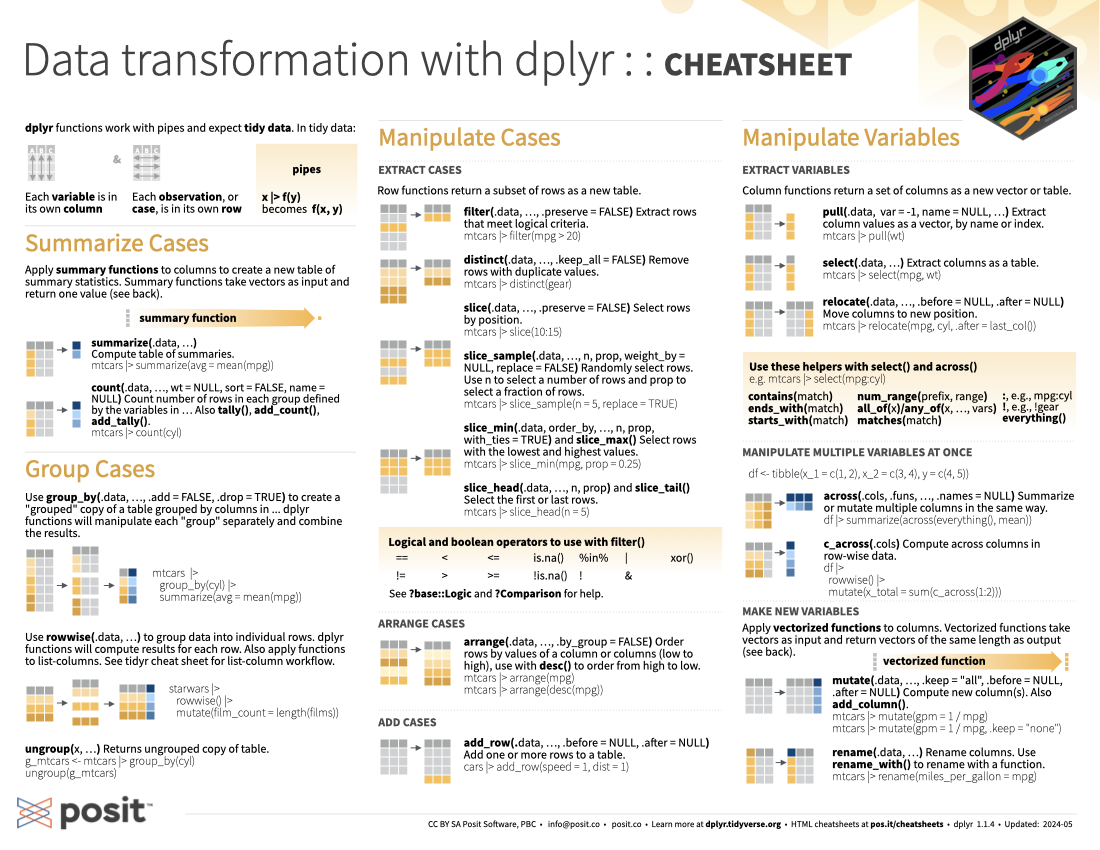
Download PDF

Translations (PDF)
dplyr functions work with pipes and expect tidy data. In tidy data:
x |> f(y) becomes f(x,y)Apply summary functions to columns to create a new table of summary statistics. Summary functions take vectors as input and return one value back (see Summary Functions).
summarize(.data, ...): Compute table of summaries.
count(.data, ..., wt = NULL, sort = FLASE, name = NULL): Count number of rows in each group defined by the variables in .... Also tally(), add_count(), and add_tally().
Use group_by(.data, ..., .add = FALSE, .drop = TRUE) to created a “grouped” copy of a table grouped by columns in .... dplyr functions will manipulate each “group” separately and combine the results.
Alternate grouping syntax with .by as an argument:
Use rowwise(.data, ...) to group data into individual rows. dplyr functions will compute results for each row. Also apply functions to list-columns. See tidyr cheatsheet for list-column workflow.
ungroup(x, ...): Returns ungrouped copy of table.
Row functions return a subset of rows as a new table.
filter(.data, ..., .preserve = FALSE): Extract rows that meet logical criteria.
distinct(.data, ..., .keep_all = FALSE): Remove rows with duplicate values.
slice(.data, ...,, .preserve = FALSE): Select rows by position.
slice_sample(.data, ..., n, prop, weight_by = NULL, replace = FALSE): Randomly select rows. Use n to select a number of rows and prop to select a fraction of rows.
slice_min(.data, order_by, ..., n, prop, with_ties = TRUE) and slice_max(): Select rows with the lowest and highest values.
slice_head(.data, ..., n, prop) and slice_tail(): Select the first or last rows.
filter()==<<=is.na()%in%|xor()!=>>=!is.na()!&?base::Logic and ?Comparison for help.arrange(.data, ..., .by_group = FALSE): Order rows by values of a column or columns (low to high), use with desc() to order from high to low.
add_row(.data, ..., .before = NULL, .after = NULL): Add one or more rows to a table.
Column functions return a set of columns as a new vector or table.
pull(.data, var = -1, name = NULL, ...): Extract column values as a vector, by name or index.
select(.data, ...): Extract columns as a table.
relocate(.data, ..., .before = NULL, .after = NULL): Move columns to new position.
select() and across()contains(match)num_range(prefix, range):, e.g., mpg:cylends_with(match)all_of(x) or any_of(x, ..., vars)!, e.g., !gearstarts_with(match)matches(match)everything()across(.cols, .fun, ..., .name = NULL): summarize or mutate multiple columns in the same way.
c_across(.cols): Compute across columns in row-wise data.
Apply vectorized functions to columns. Vectorized functions take vectors as input and return vectors of the same length as output (see Vectorized Functions).
mutate(.data, ..., .keep = "all", .before = NULL, .after = NULL): Compute new column(s). Also add_column().
rename(.data, ...): Rename columns. Use rename_with() to rename with a function.
mutate()mutate() applies vectorized functions to columns to create new columns. Vectorized functions take vectors as input and return vectors of the same length as output.
dplyr::lag(): offset elements by 1dplyr::lead(): offset elements by -1dplyr::cumall(): cumulative all()dply::cumany(): cumulative any()cummax(): cumulative max()dplyr::cummean(): cumulative mean()cummin(): cumulative min()cumprod(): cumulative prod()cumsum(): cumulative sum()dplyr::cume_dist(): proportion of all values <=dplyr::dense_rank(): rank with ties = min, no gapsdplyr::min_rank(): rank with ties = mindplyr::ntile(): bins into n binsdplyr::percent_rank(): min_rank() scaled to [0,1]dplyr::row_number(): rank with ties = “first”+, -, /, ^, %/%, %%: arithmetic opslog(), log2(), log10(): logs<, <=, >, >=, !=, ==: logical comparisonsdplyr::between(): x >= left & x <= rightdplyr::near(): safe == for floating point numbersdplyr::case_when(): multi-case if_else()
dplyr::coalesce(): first non-NA values by element across a set of vectors
dplyr::if_else(): element-wise if() + else()
dplyr::na_if(): replace specific values with NA
pmax(): element-wise max()
pmin(): element-wise min()
summarize()summarize() applies summary functions to columns to create a new table. Summary functions take vectors as input and return single values as output.
dplyr::n(): number of values/rowsdplyr::n_distinct(): # of uniquessum(!is.na()): # of non-NAsmean(): mean, also mean(!is.na())median(): medianmean(): proportion of TRUEssum(): # of TRUEsdplyr::first(): first valuedplyr::last(): last valuedplyr::nth(): value in the nth location of vectorquantile(): nth quantilemin(): minimum valuemax(): maximum valueIQR(): Inter-Quartile Rangemad(): median absolute deviationsd(): standard deviationvar(): varianceTidy data does not use rownames, which store a variable outside of the columns. To work with the rownames, first move them into a column.
tibble::rownames_to_column(): Move row names into col.
tibble::columns_to_rownames(): Move col into row names.
Also tibble::has_rownames() and tibble::remove_rownames().
bind_cols(..., .name_repair): Returns tables placed side by side as a single table. Column lengths must be equal. Columns will NOT be matched by id (to do that look at Relational Data below), so be sure to check that both tables are ordered the way you want before binding.bind_rows(..., .id = NULL): Returns tables one on top of the other as a single table. Set .id to a column name to add a column of the original table names.Use a “Mutating Join” to join one table to columns from another, matching values with the rows that the correspond to. Each join retains a different combination of values from the tables.
left_join(x, y, by = NULL, copy = FALSE, suffix = c(".x", ".y"), ..., keep = FALSE, na_matches = "na"): Join matching values from y to x.right_join(x, y, by = NULL, copy = FALSE, suffix = c(".x", ".y"), ..., keep = FALSE, na_matches = "na"): Join matching values from x to y.inner_join(x, y, by = NULL, copy = FALSE, suffix = c(".x", ".y"), ..., keep = FALSE, na_matches = "na"): Join data. retain only rows with matches.full_join(x, y, by = NULL, copy = FALSE, suffix = c(".x", ".y"), ..., keep = FALSE, na_matches = "na"): Join data. Retain all values, all rows.Use a “Filtering Join” to filter one table against the rows of another.
semi_join(x, y, by = NULL, copy = FALSE, ..., na_matches = "na"): Return rows of x that have a match in y. Use to see what will be included in a join.anti_join(x, y, by = NULL, copy = FALSE, ..., na_matches = "na"): Return rows of x that do not have a match in y. Use to see what will not be included in a join.Use a “Nest Join” to inner join one table to another into a nested data frame.
nest_join(x, y, by = NULL, copy = FALSE, keep = FALSE, name = NULL, ...): Join data, nesting matches from y in a single new data frame column.Use by = join_by(col1, col2, …) to specify one or more common columns to match on.
Use a logical statement, by = join_by(col1 == col2), to match on columns that have different names in each table.
Use suffix to specify the suffix to give to unmatched columns that have the same name in both tables.
intersect(x, y, ...): Rows that appear in both x and y.setdiff(x, y, ...): Rows that appear in x but not y.union(x, y, ...): Rows that appear in x or y, duplicates removed. union_all() retains duplicates.setequal() to test whether two data sets contain the exact same rows (in any order).CC BY SA Posit Software, PBC • info@posit.co • posit.co
Learn more at dplyr.tidyverse.org.
Updated: 2025-08.